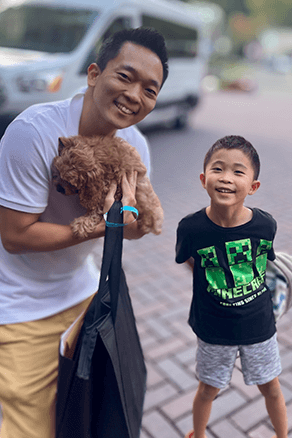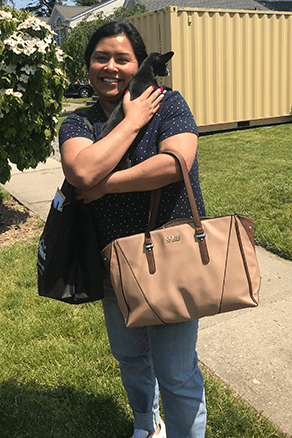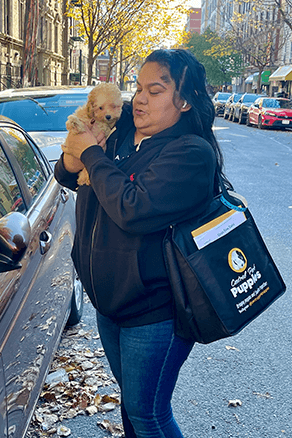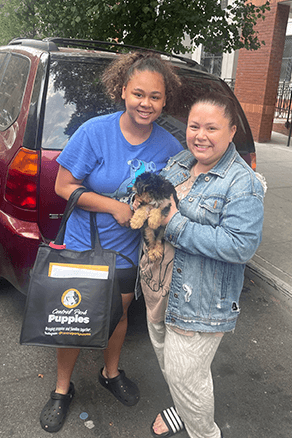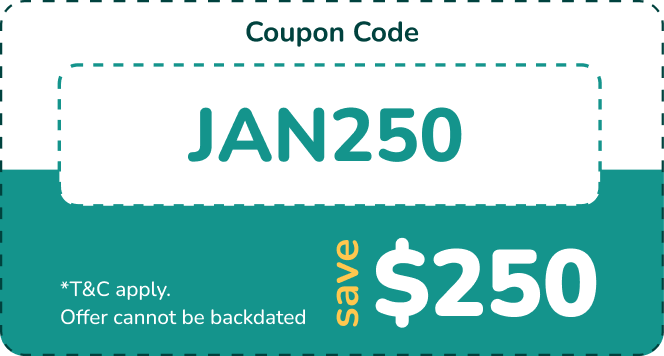Getting a puppy is an exciting and rewarding experience that comes with many responsibilities. Grooming your new pup is one of those essential tasks. Not only will regular grooming keep them looking their best, but it's also great for forming a solid bond between you and your puppy as they get settled in their new home. This article will cover the basics of first-time puppy grooming so that you can prepare your furry friend for the future.
The joys of bringing home a new puppy
Bringing home a new puppy is an exciting experience for any pet owner, and the joy of having a furry friend to love and care for is unparalleled. But before you enjoy all the cuddles, a crucial step needs to be taken: helping your pup get comfortable with being groomed.
A good brushing routine should start early to prevent tangles and matting and keep your dog's coat healthy. Young puppies need to be brushed more often than adults as they shed their coats and get their adult fur. Puppies with longer, curly, or double coats require even more frequent grooming.
Remember that puppies are also susceptible to stress and fear, so use positive reinforcement and a soothing voice while introducing them to grooming.
The importance of grooming for a puppy's health and well-being
Regular grooming is essential for a puppy's health and well-being, but first-time puppy owners may feel overwhelmed or need help with how to groom their pup.
It's important to understand that all breeds require a certain degree of grooming, including brushing and trimming. Puppy coats can range from long and curly to short and smooth, so it's essential to be aware of your pup's specific breed and coat type.
Brushing your puppy's coat with a bristle brush or slicker brush can keep their hair healthy and remove any dead hair. Establishing a nail trimming routine from an early age and brushing their teeth with specially formulated puppy toothpaste is also important.
Basic grooming tools and supplies
Grooming your pet can be a fun and rewarding experience. To ensure that it is as safe and successful as possible, it is important to have the right tools and supplies. Essential grooming tools and supplies include a brush or comb, scissors or clippers, shampoo and conditioner, nail clippers, and ear cleaning solution.
Brush or comb
A brush or comb removes dirt, debris, mats, and tangles from your pet's coat. Depending on the type of fur your pet has, you may need to use different types of brushes or combs. For example, a slicker brush works best for long-haired dogs, while a pin brush is better suited for short-haired breeds.
Scissors or clippers
If you ever plan to give your pet a trim, scissors or clippers are necessary. Clippers are ideal for larger areas, such as the back, while scissors are better for smaller areas around the eyes and ears. Use sharp blades to avoid pulling at your pet's fur.
Many puppy parents do not opt for a full haircut until their pup has an adult coat, usually around six months old. However, if needed, you can use scissors to give your puppy's coat a gentle trim.
Shampoo and conditioner
Use Shampoo and conditioner regularly to keep your pet's coat clean and healthy. Look for products specifically designed for pets that contain natural ingredients such as aloe vera and oatmeal, which help soothe skin irritation.
Nail clippers
Nail clippers are vital in keeping your pet's nails trimmed properly. Be sure to use clippers designed specifically for pets since human nail clippers can cause injury if misused.
Ear cleaning solution
Finally, use an ear-cleaning solution regularly to remove any wax buildup in your pet's ears, which can lead to infection if left untreated. Look for solutions with natural ingredients such as tea tree oil which helps reduce inflammation due to its antibacterial properties.
How do I clean my puppy's ears?
Cleaning your puppy's ears is essential to keeping them healthy and happy. To ensure that you are doing it correctly, here are some easy steps to follow:
- Start by gently touching your puppy's ears and stroking them to gauge their reaction. If they don't seem to like it, don't force it!
- You will need a few supplies, such as cotton balls or gauze, a dog ear-cleaning solution, and a towel. Avoid using cotton swabs, as they can push the wax further into the ear canal.
- Dampen a cotton ball with the cleaning solution and wipe away any dirt or wax from the entrance of the ear canal and around the pinna (the outer flap of the ear).
- Massage your puppy's ears for 20-30 seconds to help loosen any debris in their ear canals.
- Use a new dampened cotton ball to wipe away debris inside their ears.
- Give your puppy lots of treats throughout this process to reward them for being patient!
Following these simple steps can easily keep your puppy's ears clean and healthy!
How To Prepare Your Puppy for Grooming
Once you've established a regular grooming routine, it's time to prepare your puppy for their first professional grooming session.
Make an appointment
Making an appointment is the first step in getting your puppy groomed. Most professional groomers require appointments for puppies, so it's essential to plan.
Familiarize your pet with the grooming process
Before the appointment, it's helpful to familiarize your pet with the grooming process. Start by gently massaging their head and body, then brush their fur, trim their nails and brush their teeth. Be sure to use positive reinforcement throughout the process.
Speak to the groomer beforehand
Take some time to speak with the groomer beforehand. It's important to let them know about your pet's coat type, whether they are long-haired or short-haired, and any groomers they may have used in the past. This will help make sure your puppy is comfortable during their first visit.
You can request a full haircut and blow dry for your pup if you'd like. Ask if the groomer will use styling products such as gels, sprays, or scented shampoos. It's also important to ensure their water temperature is lukewarm and ask if they use styptic powder for nail trimming.
Prepare for the appointment
On the day of your puppy's first grooming session, bring along any necessary supplies, such as toys to keep them busy and a towel to wrap them in when they are done, for added comfort and warmth.
Handle gently and use a soothing voice
When handling your puppy at the grooming salon, it is essential to use a gentle touch and a soft voice. This will help your puppy stay calm and get used to being handled by strangers.
Give positive reinforcement
Giving your pup lots of positive reinforcement during their first grooming session is key. This can come in the form of treats or verbal praise. Rewarding your pup for good behavior will help them get used to the process and make future visits much smoother.
How often to groom a puppy
If you want to keep your pup's fur looking its best, here are some tips on how often to groom them:
- Bathe your pup every four to six weeks: When it comes to bathing, it is important to bathe your pup every four to six weeks. This will help keep their coat clean and healthy and prevent their fur from becoming matted.
- Brush their coat daily, especially if they have long hair: Brush your pup's coat daily to keep it healthy and tangle-free. Longer-haired breeds should be brushed more often to avoid matting.
- Clean their ears weekly: Clean your pup's ears every week with a natural ear-cleaning solution to help prevent infection and keep their ears healthy.
- Give them a haircut every 8-12 weeks: Depending on the breed and coat type, most pups will need a full haircut every 8-12 weeks. This helps keep their coat healthy and looking its best.
Tips for making grooming a positive experience for both you and your puppy
Grooming your puppy can be a challenging experience, but it doesn't have to be. Here are some tips to make the process as stress-free and enjoyable as possible!
- Start grooming your puppy from a young age, so they get used to it.
- Use treats and positive reinforcement to make the experience enjoyable for your pup.
- Before beginning the grooming process, ensure you have all the necessary tools, such as brushes, combs, clippers, shampoo, and conditioner.
- Brush your pup regularly to remove dirt and debris from their coat and keep it healthy and shiny.
- Trim your pup's nails regularly to prevent them from becoming too long or sharp, which can cause discomfort when walking or running.
- Bathe your pup regularly with a mild shampoo designed for dogs to keep their skin clean and free of bacteria or parasites that can cause skin irritation or infection.
- Check for any lumps, bumps, or other abnormalities on your pup's body during grooming sessions, as this could indicate a more severe issue that needs to be addressed by a veterinarian immediately.
- Be patient with your pup while grooming, as it may take some time for them to become comfortable with the process if they are not used to it yet.
- Talk softly and calmly while grooming your pup, as this will help keep them relaxed throughout the session.
- Always end each session with lots of praise and rewards, such as treats or toys, so they associate grooming with something positive!
The importance of regular grooming throughout a puppy's life
Regular grooming is essential to their health and well-being as a puppy grows. Not only does it keep them looking their best, but it also helps prevent skin and coat problems, as well as other health issues.
When should puppies get their first haircut?
Grooming should start early in a puppy's life. At around 10-12 weeks old, they should be ready for their first haircut. This should be a gentle introduction, with light brushing, a hair trim, and a nail-cutting session.
Physical benefits of regular grooming
Regular grooming sessions are essential for puppies because they help maintain healthy skin and coats. During these sessions, groomers can check for any potential skin or coat problems that may have developed since the last visit. They can also trim nails and clean ears to ensure your pup stays healthy and comfortable. Finally, regular grooming helps puppies adjust to being handled by humans, which is critical for socialization and establishing trust.
Emotional benefits of regular grooming
In addition to helping maintain good physical health, regular grooming sessions are also beneficial for puppies' mental health. Groomers provide a safe environment where pups can relax while being cared for by someone who loves animals. This helps build trust between dogs and the humans caring for them, which is essential for healthy relationships. It's also imperative during those early months when pups are still learning about the world around them to ensure they have positive experiences with grooming.
Overall, regular grooming throughout a puppy's life is essential to keeping them healthy and happy!
FAQs
At what age can I start getting my puppy groomed?
It's best to wait until your pup is 10-12 weeks old before taking them for their first grooming session. This will give them time to adjust to their new environment and get used to being handled.
Puppy grooming prices?
Puppy grooming prices vary by groomer and location but typically range from $25-$80.
How do I know if my puppy has matted fur?
Matting is when the fur becomes tangled and knotted together, making it difficult to brush. It's most common in long-haired breeds, but can also occur in curly coats or short hair. If you notice your pup's fur has become matted, it's important to take them for a professional groomer as soon as possible.
How to get puppy used to grooming?
The best way to get your pup groomed is to start slowly and ensure they are always comfortable. Talk softly, use gentle brushing techniques, and reward them with treats and praise. Introduce the different grooming tools gradually, such as a bristle brush, slicker brush, or blowdryer.
How long does it take for a dog to be groomed?
The length of time a pup is being groomed can vary depending on the size and coat type of the dog, as well as how much styling is required. Generally, a full haircut will take between 30-90 minutes. For shorter haircuts or just brushing and combing, it usually takes around 15-30 minutes.
Do puppies need nails trimmed?
The answer is yes! Nail trimming is essential to puppy care and should be done to keep your pup's paws healthy.
It's best to start early, as soon as you bring your puppy home. This will help them get used to the process and make it easier for you and your pup. You should plan to trim their nails at least once a week or when you can hear them tapping on the floor.
Be sure to use a sharp nail clipper designed specifically for dogs, and take extra care around the quick - the pink area in each nail that contains blood vessels and nerves. If you accidentally cut into it, it will hurt your pup and cause bleeding.
Is it safe to take dog to groomer?
Yes, it is generally safe to take your pup to the groomer. Researching and finding a professional groomer with experience with puppies is essential. You should always ask to see the salon before your pup's first visit and ensure it is clean and well-maintained.
Final Thoughts
Gently handling and regularly grooming your new puppy from an early age is a great foundation for developing a strong bond with them. It's important to remember that getting your pup used to the grooming process takes time and patience. With positive reinforcement, a lot of love, and a soothing voice, your pup will quickly learn that grooming is a safe and pleasant experience.
Regular brushing and nail trimming will allow their coat to stay healthy and strong and can help prevent matting and tangling of their fur. And finally, if you want to give your pup a full haircut, it's best to leave it up to a professional groomer, who can safely and accurately trim their fur.
With these tips in mind, you and your pup can look forward to many enjoyable grooming sessions together. If you found this article helpful, we hope you will share it!















